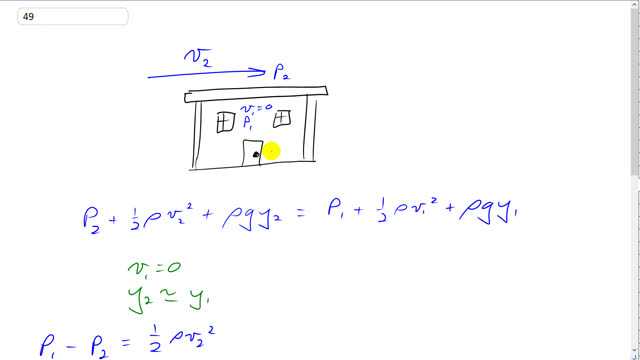
A 180-km/h wind blowing over the flat roof of a house causes the roof to lift off the house. If the house is in size, estimate the weight of the roof. Assume the roof is not nailed down.

In order to watch this solution you need to have a subscription.
This is Giancoli Answers with Mr. Dychko. Here's our picture: we have a house with windows and doors closed so that the wind is not moving inside which by the way if there's like, you know, strong winds and you are worried about the house, roof lifting off, you should maybe open the doors and open the windows and run into the basement so that you have some velocity in here because it's the fact that the velocity is zero in here, this is what results in a pressure difference between the inside of the house and outside. The high velocity wind outside has a low pressure and the low velocity wind inside the house will have a higher pressure and it's this pressure difference that results in a pressure upwards on the roof and therefore a force upwards which lifts the roof off. So outside the roof on top of it we have P 2 plus one-half density of air times its speed squared plus ρgy 2 equals the pressure inside the house plus one-half density times v 1 squared plus ρgy 1. So v 1 we just said is zero so that term is gone; y 2 is essentially the same as y 1, there's no real height difference it's just the thickness of the roof and that's negligible so these two terms are equal so they disappear. And we'll bring this P 2 to the right hand side and we have P 1 minus P 2 and switch the sides around, P 1 minus P 2 equals one-half density of air times its speed squared. So this pressure difference is the pressure that the roof experiences and pressure equals force divided by area and this is the force upwards on the roof divided by the area of the roof. We'll solve this for F by multiplying both sides by A and then we get the force is pressure times area and the pressure is one-half ρv 2 squared times the area of the roof and that's one-half times 1.29 kilograms per cubic meter—density of air— times 180 kilometers per hour divided by 3.6 essentially, squared and then times by—the area of the roof— 6.2 times 12.4 and that gives about 1.2 times 10 to the 5 newtons will be the force on the roof.
Shouldn’ it be like 1.2 x 10^4?
Shouldn’ it be like 1.2 x 10^4?